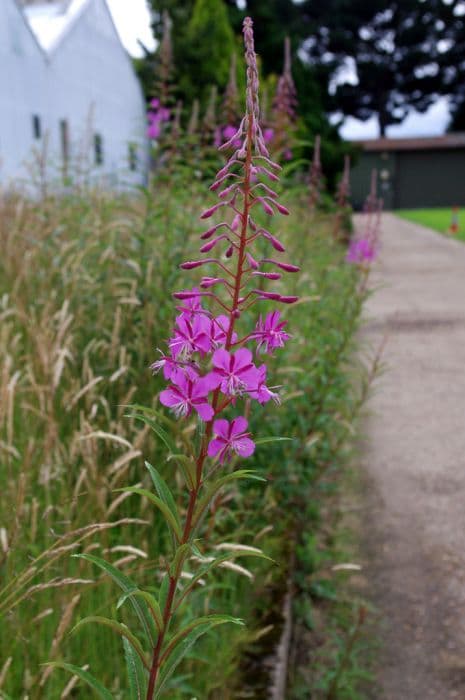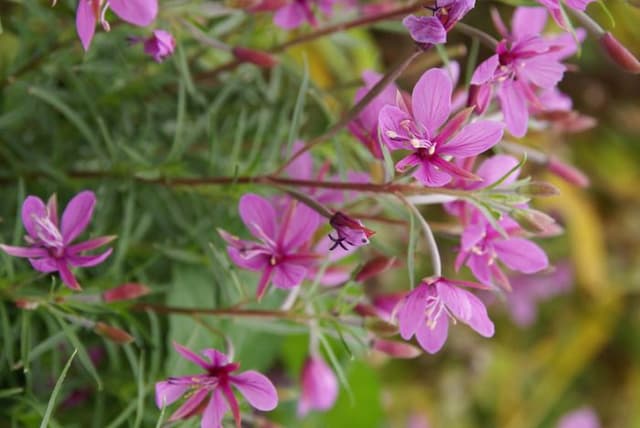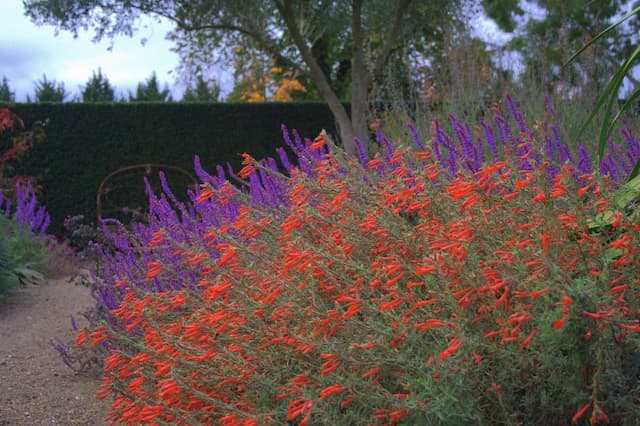Evening Primrose Oenothera stricta 'Sulphurea'

ABOUT
The Evening Primrose 'Sulphurea' is a captivating plant that bears a distinct appearance with its intriguing foliage and showy flowers. The leaves of the Evening Primrose are narrow and lance-shaped, giving the plant a somewhat delicate and textured look. The color of the leaves tends to be a soft green, which serves as the perfect backdrop for the plant's true showstoppers—the blossoms. The flowers of the 'Sulphurea' variant are particularly striking, with their soft, sulphur-yellow petals that exude a gentle and warm color. These blossoms are typically large and cup-shaped, inviting a closer look from onlookers and providing a visual feast. The petals are arranged in a cross pattern which is characteristic of the Evening Primrose family, adding a sense of order and symmetry to the plant's natural beauty. As a night-blooming species, the Evening Primrose 'Sulphurea' opens its flowers in the evening, adding a sense of enchantment to the garden as the sun sets. The flowers often release a subtle and pleasing fragrance that can attract nocturnal pollinators to the garden, adding another layer of intrigue to this lovely plant. The Evening Primrose demonstrates a bushy growth habit, which allows the clusters of yellow flowers to stand out against the green foliage, creating a delightful contrast that can brighten up any garden space. The overall impression of the Evening Primrose 'Sulphurea' is one of grace and vivacity, making it a cherished addition to flowerbeds, borders, and even containers, where its charming blooms can be admired up close.
About this plant
 Names
NamesFamily
Onagraceae
Synonyms
Sulfur Evening Primrose, Strict Sundrops
Common names
Oenothera stricta.
 Toxicity
ToxicityTo humans
The Evening Primrose (Oenothera stricta 'Sulphurea') is not widely recognized as a toxic plant to humans. There is limited information available on severe toxicity from ingesting this plant. However, it is generally advisable not to eat or handle plants if you are unsure of their safety, as individuals could potentially experience mild discomfort or an allergic reaction.
To pets
The Evening Primrose (Oenothera stricta 'Sulphurea') is not commonly listed as toxic to pets, such as dogs and cats. There is limited evidence to suggest severe poisoning can occur from ingestion. As with any non-food plant, it is best to prevent pets from consuming it in significant amounts as it could possibly cause gastrointestinal upset or an allergic reaction, although this is not well documented.
 Characteristics
CharacteristicsLife cycle
Perennials
Foliage type
Deciduous
Color of leaves
Green
Flower color
Yellow
Height
2 feet (60 cm)
Spread
2 feet (60 cm)
Plant type
Herb
Hardiness zones
5
Native area
South America
Benefits
 General Benefits
General Benefits- Attracts Pollinators: Oenothera stricta 'Sulphurea', commonly known as Sulfur Evening Primrose, is known to attract bees, butterflies, and other pollinators, which is beneficial for the overall health of gardens and ecosystems.
- Drought Tolerant: Once established, Sulfur Evening Primrose is tolerant to drought, making it suitable for xeriscaping and ideal for gardens in arid climates or for water conservation efforts.
- Easy to Grow: This plant is known for being easy to grow and maintain, which makes it a good choice for novice gardeners or those looking for low-maintenance landscaping options.
- Landscape Beautification: With its bright yellow flowers, Sulfur Evening Primrose adds a splash of colour to gardens and landscapes, enhancing the aesthetic appeal of outdoor spaces.
- Nocturnal Blooming: The flowers of Sulfur Evening Primrose usually open in the evening, adding interest and unique beauty to gardens during nighttime hours.
 Medical Properties
Medical Properties- This plant is not used for medical purposes.
 Air-purifying Qualities
Air-purifying QualitiesThis plant is not specifically known for air purifying qualities.
 Other Uses
Other Uses- Oenothera can provide a dye for fabrics, deriving from the plant's petals which can offer a range of colors from yellow to green hues.
- The nectar and pollen-rich flowers serve as an excellent food source for nocturnal pollinators, such as moths.
- Oenothera's sturdy stems can be utilized as natural support for weaker plants in the garden, propping them up as they grow.
- The sap inside the stems of Oenothera has been used as a natural adhesive in traditional crafts and repairs.
- Due to its robust and rapid growth, Oenothera can function as a ground cover to prevent soil erosion on slopes.
- The plant is known to be used as a natural dye indicator for pH levels, changing colors depending on the acidity of the solution.
- Oenothera is sometimes planted in rain gardens due to its ability to withstand wet conditions and help with water filtration.
- The dense growth habit can provide an excellent hiding and nesting ground for small wildlife, contributing to biodiversity.
- Crushed leaves and stems of Oenothera can be infused in water to create a fragrant rinse for freshening up linens and clothes.
- While not a typical use, the fibrous roots of Oenothera have been experimentally used to craft small-scale paper products.
Interesting Facts
 Feng Shui
Feng ShuiThe Evening Primrose is not used in Feng Shui practice.
 Zodiac Sign Compitability
Zodiac Sign CompitabilityThe Evening Primrose is not used in astrology practice.
 Plant Symbolism
Plant Symbolism- Evening Primrose (Oenothera stricta 'Sulphurea') is often associated with patience and anticipation because it typically opens its flowers in the evening or at night.
- The plant symbolizes youth or fleeting beauty, as its flowers are short-lived, often wilting within a day.
- It also represents resilience and adaptability as many species of evening primrose thrive in challenging environments and are able to reseed themselves.
- In alternative medicine and symbolic language, evening primrose is connected to healing and fertility, as its oil is said to have numerous health benefits.
- Some cultures might attribute the meaning of affection and romantic love to evening primrose, possibly due to the intensity and briefness of its blooms similar to a passionate but short-lived affair.
 Water
WaterEvening Primrose (Oenothera stricta 'Sulphurea') should be watered deeply but infrequently to encourage a strong root system. Allow the soil to dry out between waterings, providing about 1 inch of water once a week during the growing season. Less water is required during the fall and winter when the plant is dormant—cut back to watering every few weeks or when the soil is dry to the touch. If grown in containers, be sure to water until it runs out of the drainage holes, indicating the soil is thoroughly moistened. During hot and dry weather, monitoring the soil moisture is crucial; additional watering might be necessary.
 Light
LightEvening Primrose prefers full sun to thrive, meaning it should receive at least 6 to 8 hours of direct sunlight daily. The best spot for this plant is an area where it can enjoy uninterrupted daylight, away from the shade of larger plants or structures. In regions with extremely hot climates, providing light afternoon shade will prevent scorching.
 Temperature
TemperatureEvening Primrose is relatively hardy and can tolerate a range of temperatures, but it performs best in conditions between 60°F and 80°F. It can survive minimum temperatures down to approximately 20°F and maximum temperatures up to around 90°F. Avoid exposure to temperatures below this range to prevent cold damage and above it to avoid heat stress.
 Pruning
PruningEvening Primrose should be pruned to remove spent flowers and encourage further blooming throughout the season. Prune back the plants by about one-third after the initial flowering to promote a second bloom. Deadheading, or removing faded flowers, can be done regularly. The best time for major pruning is early spring or after the plant has finished flowering in the fall.
 Cleaning
CleaningAs needed
 Soil
SoilEvening Primrose requires well-draining soil with a pH around 5.5 to 7. A mixture of garden soil, sand, and peat or compost will provide an ideal growing medium for 'Sulphurea' cultivar.
 Repotting
RepottingEvening Primrose should be repotted once it outgrows its current container, which typically happens every 1-2 years, to accommodate its root growth and maintain soil freshness.
 Humidity & Misting
Humidity & MistingEvening Primrose thrives in average room humidity levels and does not require any special humidity adjustments.
 Suitable locations
Suitable locationsIndoor
Place Evening Primrose in a well-lit spot with direct light.
Outdoor
Ensure full sun and protect from strong winds for Evening Primrose.
Hardiness zone
5-9 USDA
 Life cycle
Life cycleOenothera stricta 'Sulphurea', commonly known as Evening Primrose, begins its life cycle with seed germination, which occurs in late winter to spring in well-drained soil under full sunlight or partial shade. The seedlings develop into a basal rosette of leaves, and from this rosette, the plant sends up tall flowering stems in early summer. Its flowers are yellow, opening in the evening and often wilting by the next afternoon, thus pollinated mainly by nocturnal insects, like moths. After pollination, the plant produces fruits, which are elongated capsules containing numerous tiny seeds. The plant is perennial, so after flowering, it can die back to its rosette form to survive the winter, and re-sprout the following spring to start the cycle anew. Some plants may live several years, while others behave more as biennials, completing their life cycle in two growing seasons.
 Propogation
PropogationPropogation time
Spring to Summer
The Evening Primrose 'Sulphurea' can be propagated through seeds as the most popular method. This process usually begins in late winter or early spring. To propagate, first collect seed pods from the plant once they have dried on the plant. Open the pods and shake out the tiny seeds. Sow the seeds directly into the garden in a location that receives full sun. Lightly press the seeds into the soil but do not cover them, as they need light for germination. Keep the soil moist until germination, which usually occurs within two to three weeks. After seedlings have developed a few true leaves, they can be thinned out if necessary to prevent overcrowding.









